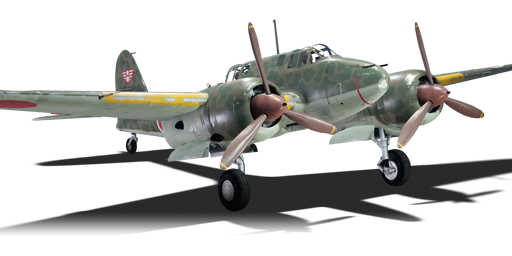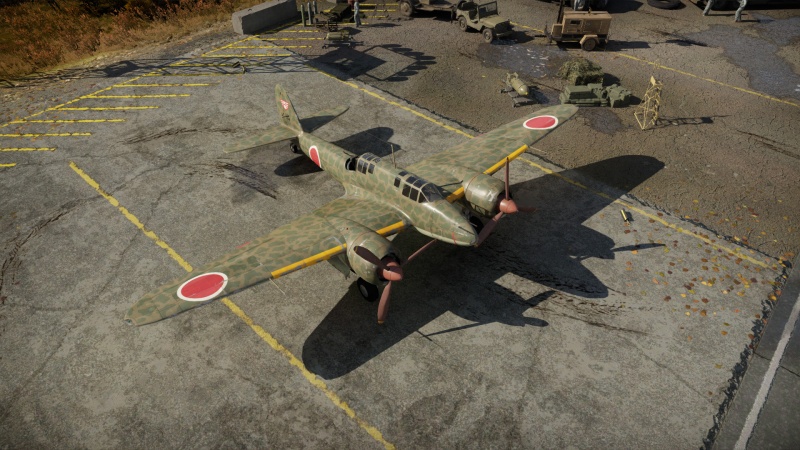Ki-45 otsu
| This page is about the Japanese twin-engine fighter Ki-45 otsu. For other versions, see Ki-45 (Family). |
Contents
Description
The Ki-45 otsu Toryu is a rank I Japanese twin-engine fighter with a battle rating of 1.7 (AB), 2.3 (RB), and 2.7 (SB). It was introduced in Update 1.31.
Being a classed as a heavy fighter, the Ki-45 isn't the best in the manoeuvrability department. However, for a heavy fighter, it manoeuvres very well. It is even capable of out-turning aircraft such as the P-47D-25. Unlike heavy fighters of other nations, the Ki-45 series does not feature aircraft with large amounts of heavy weaponry. This is a major downside, considering how heavy fighters traditionally give up manoeuvrability and speed for armament. Instead, the Ki-45s utilise more of a balance between manoeuvrability, speed, and armament. These are what makes the Ki-45 both a capable dog-fighter, and bomber hunter.
General info
Flight performance
| Characteristics | Max Speed (km/h at 6,300 m) |
Max altitude (metres) |
Turn time (seconds) |
Rate of climb (metres/second) |
Take-off run (metres) | |||
|---|---|---|---|---|---|---|---|---|
| AB | RB | AB | RB | AB | RB | |||
| Stock | 552 | 539 | 9900 | 24.8 | 25.5 | 17.0 | 17.0 | 520 |
| Upgraded | 588 | 570 | 23.7 | 24.0 | 22.4 | 19.5 | ||
Details
| Features | ||||
|---|---|---|---|---|
| Combat flaps | Take-off flaps | Landing flaps | Air brakes | Arrestor gear |
| ✓ | ✓ | ✓ | X | X |
| Limits | ||||||
|---|---|---|---|---|---|---|
| Wings (km/h) | Gear (km/h) | Flaps (km/h) | Max Static G | |||
| Combat | Take-off | Landing | + | - | ||
| 712.5 | 350 | 450 | 450 | 290 | ~11 | ~7 |
| Optimal velocities (km/h) | |||
|---|---|---|---|
| Ailerons | Rudder | Elevators | Radiator |
| < 360 | < 320 | < 450 | > 330 |
| Compressor (RB/SB) | ||
|---|---|---|
| Setting 1 | ||
| Optimal altitude | 100% Engine power | WEP Engine power |
| 1,800 m | 1,040 hp | 1,136 hp |
| Setting 2 | ||
| Optimal altitude | 100% Engine power | WEP Engine power |
| 5,100 m | 935 hp | 1,021 hp |
Survivability and armour
- 16 mm Steel plates behind the pilot
Modifications and economy
Instead of focusing on armament like other heavy fighters, the Ki-45 is more balanced between armament and flight performance. While the default ammunition belts for both weapons on the Ki-45 ko are workable, it can help to upgrade. Unlocking the flight performance modules will help drastically in dogfights and turn fights.
Armaments
Offensive armament
The Ki-45 otsu is armed with:
- 1 x 37 mm Type 94 army cannon, belly-mounted (16 rpg)
- 2 x 12.7 mm Ho-103 army machine guns, nose-mounted (350 rpg = 700 total)
Defensive armament
The Ki-45 otsu is defended by:
- 1 x 7.92 mm Type 98 army machine gun, dorsal turret (1,050 rpg)
Usage in battles
This variant of the Ki-45, the Ki-45 otsu, features the first "hard-hitting" armament of the series. Wielding two Ho-103 12.7 mm guns and one 37 mm Type 94 cannon, the Ki-45 otsu is the pinnacle of a multi-purpose aircraft. Its 37 mm cannon allows it to take down bombers with ease, and its nose-mounted 12.7 mm guns allows for some flexibility in the dog-fighting department. Although deadly, the 37 mm cannon only holds 16 rounds, so shot placement is crucial. The round itself also travels fairly slowly in the air, making it hard to hit fast moving enemy fighters. The 12.7 mm guns is best used in an anti-fighter role. Fortunately, the Ki-45 Otsu can also be used in an anti-tank role, thanks to the AP rounds for the 37 mm cannon (42 mm penetration), which can take out light and medium tanks, light pillboxes, and even a few player controlled tanks. The Ki-45 is unable to equip bombs.
The Ki-45 otsu also retains its impressive turn rate from the Ki-45 ko. Although the aircraft itself is large and presents an "easy target" in many players' minds, the Ki-45 is rather nimble. Use this to your advantage when engaging enemy aircraft. Unfortunately, the Ki-45 is a heavy fighter, meaning its turn time is still not on par with other aircraft such as the F2A-3. In certain cases, the Ki-45 pilot may have to rely on his or her tail gunner to get the job done. The "otsu" version of the Ki-45 features a 7.92 mm Type 98 machine gun with 1,050 rounds. Although lacklustre, with shot placement it is possible to destroy enemies on the aircraft's tail. Aim for the pilot or the engine, as those are generally the weakest points on most aircraft. If the tailing enemy is a bi-plane, aim for the wings since they are very fragile.
The Toryu is also rather fragile for a heavy fighter. Although it does feature two engines, the Ki-45 does not have very much armour protection. Only the back of the pilot's seat has armour, leaving both the gunner and engines unprotected. This can prove costly in a fight. If one does find him or herself tailed, call upon teammates for assistance.
- In simulator, the Ki-45 has a decent frontal view with large pieces of glass in front, on top and to the sides, ensuring great visibility. The gunsight has enough room under, allowing easy tracking and leading of targets. However the side views are terrible as the wings & engines block out most of the view downwards, and a thick frame blocks out the upper area, as a result the common way of circling above an area to spot something is extremely limited. Rear visibility is almost non existent with the entire tail obstructed by the headset.
Manual Engine Control
| MEC elements | ||||||
|---|---|---|---|---|---|---|
| Mixer | Pitch | Radiator | Supercharger | Turbocharger | ||
| Oil | Water | Type | ||||
| Controllable | Controllable Not auto controlled |
Controllable Auto control available |
Controllable Auto control available |
Separate | Controllable 2 gears |
Not controllable |
Pros and cons
Pros:
- Highly powerful 37 mm cannon
- Armour piercing (42 mm penetration) shots for anti-tank purposes
- Good manoeuvrability and climb rate for a heavy fighter
- Acceptable top speed
- 16.5 mm of armour in pilot's seat
- Two engine design
Cons:
- Beat in turn fights by some aircraft
- Prone to fuel and engine fires
- Locks up at high speeds
- Mediocre roll rate, gets worse as speed increases
- Limited ammunition for all weapons
- Lack of protection around fuel tanks, engines, and gunner
- Long cannon reload
- Pilot is exposed in head-ons
History
Initially designed to be a bomber escort, the Ki-45 was first deployed in what is now China and Vietnam. It was found to be easily outclassed by P-40s piloted by the Flying Tigers. As a result, the Ki-45's role was changed to anti-shipping and ground attack, where it performed satisfactorily. Nonetheless, the Ki-45's greatest strength proved to be its bomber intercepting capabilities. Heavily armed with 37 mm cannon, the Toryu (Dragon Slayer) could destroy heavy bombers with ease. As the war progressed, the need for an interceptor to defend the Japanese mainland was ever present. Soon, the Ki-45 was deployed to counter B-29 Superfortress raids. Although its armament was clearly deadly enough, the Ki-45 suffered at high altitudes. Pilots soon resorted to ramming attacks against the Superfortresses. Special attack groups specifically designed for this purpose formed, but by late 1945 Imperial Japan's fate had been sealed. The Allies allocated the name "Nick" to the Ki-45.
In-game description
Kawasaki Ki-45 KAI Otsu (Model B) Type 2 Toryu (Allied reporting name: Nick) twin-engine army fighter
Combat experience showed that the Toryu was particularly good as a ground-attack aircraft for striking ground and surface targets. In order to improve the effective use of the Ki-45 for anti-ship and ground attack tasks, the special Ki-45 KAI Otsu version was launched into full-scale production.
Aircraft of this version were equipped with new Mitsubishi Ha-102 fourteen-cylinder, radial air-cooled engines producing a takeoff power of 1,080 hp. These engines were housed in nacelles which had a smaller diameter when compared to previous versions. The aircraft's flight characteristics remained unchanged, since the increased engine power was accompanied by a larger takeoff weight; however, the improved reliability of the Ha-102 engines was appreciated by flying and maintenance personnel.
The aircraft's armament was drastically reinforced. The nose-mounted 12.7 mm machine guns were replaced by one 20 mm Ho-3 cannon with 50 rounds. The ventral nacelle housed a 37 mm Type 94 manually loaded cannon with 16 rounds. The 7.92 mm Type 98 machine gun with 1,050 rounds remained in the rear defensive turret.
The installation of the new front armament meant changing the shape of the nose fairing, and additional access doors were cut in the skin. The landing headlight was moved from the nose section to the left wing leading edge.
The Ki-45 KAI Otsu was used extensively to attack various ground and surface targets.
Media
Excellent additions to the article would be video guides, screenshots from the game, and photos.
See also
Links to the articles on the War Thunder Wiki that you think will be useful for the reader, for example:
- reference to the series of the aircraft;
- links to approximate analogues of other nations and research trees.
External links
Paste links to sources and external resources, such as:
- topic on the official game forum;
- encyclopedia page on the aircraft;
- other literature.
| Kawasaki Aircraft Industries (川崎航空機工業株式会社) | |
|---|---|
| Biplane Fighters | Ki-10-I · Ki-10-I C · Ki-10-II · Ki-10-II C |
| Fighters | Ki-61-I ko · Ki-61-I otsu · Ki-61-I hei · Tada's Ki-61-I hei · Ki-61-I tei · Ki-61-II Otsu Kai |
| Ki-100 · Ki-100-II | |
| Interceptors | Ki-45 ko · Ki-45 otsu · Ki-45 hei · Ki-45 tei |
| Ki-96 | |
| Ki-102 otsu | |
| Ki-108 Kai | |
| Bombers | Ki-32 |
| Ki-48-II otsu | |
| Captured | ␗Ki-45 hei/tei · ␗Ki-61-I otsu · ▃Ki-61-Ib |
| See also | Kawasaki Shipyard Co. |
| Japan twin-engine fighters and strike aircraft | |
|---|---|
| Navy | |
| Land-based Fighter | |
| J1N | J1N1 |
| J5N | J5N1 |
| Army | |
| Ki-45 | Ki-45 ko · Ki-45 otsu · Ki-45 hei · Ki-45 tei |
| Ki-83 | Ki-83 |
| Ki-96 | Ki-96 |
| Ki-102 | Ki-102 otsu |
| Ki-108 | Ki-108 Kai |
| Ki-109 | Ki-109 |





